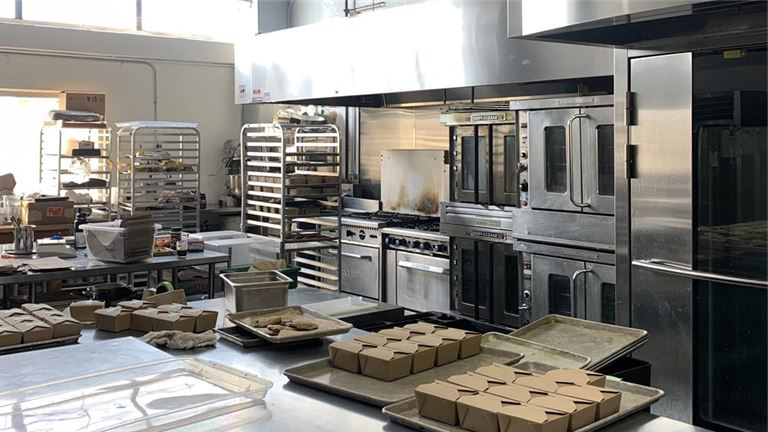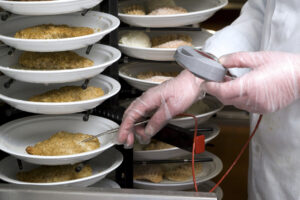[et_pb_section fb_built=”1″ _builder_version=”3.22″][et_pb_row _builder_version=”3.25″ background_size=”initial” background_position=”top_left” background_repeat=”repeat”][et_pb_column type=”4_4″ _builder_version=”3.25″ custom_padding=”|||” custom_padding__hover=”|||”][et_pb_text admin_label=”blog-text” _builder_version=”4.9.9″ custom_margin=”-50px|||” hover_enabled=”0″ saved_tabs=”all” sticky_enabled=”0″]
No matter what you call it: A cloud kitchen, a ghost kitchen or a virtual kitchen, these third-party kitchens provide restaurant owners with an alternate source of revenue that can help your establishment survive hard times.
Virtual kitchens are an exciting way that restaurants are evolving to the future of meal preparation and distribution. What is a virtual kitchen? A virtual kitchen is a low overhead space designated exclusively for the preparation of food – for pick up or delivery. And the demand for virtual kitchens has gone through the roof in just a few short years.
In fact, the trend is in step with food delivery businesses (like DoorDash) that also exploded during the pandemic, Make no mistake, delivery platforms like DoorDash and virtual kitchens are the future off the restaurant business (at least for pick up and delivery).
Virtual kitchens even go one step further – allowing restaurants to extend their brands, reduce overhead and staffing costs, while focusing on the unique needs of food prep for pick up or delivery.
What is a Virtual Kitchen?
Virtual kitchens are facilities that have a license in commercial food production. There are several models for virtual kitchens, one model is expanding an existing brick and mortar’s delivery radius by using a virtual kitchen to cover a territory you wouldn’t otherwise be able to cover (because you don’t have locations there).
Some new franchises like Mr. Beast Burger are going entirely virtual, with food distribution being handled exclusively by a virtual kitchen. Meaning there is no store front associated with the restaurant at all.
Delivery is the Future
According to marketing research IMARC Group the delivery business will continue to grow. In fact, US food delivery revenue grew from 22.0 billion in 2019 to 26.5 billion in 2020 and is expected to be 42 billion by 2025. Doordash, Grubhub, Gold Belly and Uber Eats are some of the largest restaurant delivery services in the United States but they don’t prepare the food, they work in tandem with virtual kitchens to do that.
In many cases, virtual kitchens offer optimized menu items specifically suited for quick preparation and delivery. Delivery menu items are chosen based on production efficiency and the reliability of their quality when delivered. All of the overhead of communicating with customers and performing the delivery is then handled by the delivery company. The virtual kitchen is the backend of the service chain.
Back of the House: Setting Up a Virtual Kitchen
Since most virtual kitchens operate out of warehouse districts or off the beaten path, you don’t have to worry about a expensive lease payments for a prime location. Opening a virtual kitchen costs a fraction of the overhead associated with opening a traditional brick and mortar restaurant. There are even companies that can find a virtual kitchen space for your restaurant, even the equipment. These companies manage the property and even provide timeshare options to keep costs low.
But if you prefer to partner with a virtual kitchen versus starting your own, companies like Byte Kitchen and All Day Kitchens can help get you started.
Using Point of Sale (POS) systems to manage your orders from various delivery sites removes all staffing requirements to obtain orders. A virtual kitchen can extend your brands footprint and help you even test a new market or territory you may be considering opening in.
Delivery apps and POS systems take the orders for the virtual kitchen, but they also help operators obtain and analyze lots of data. Using that data, virtual kitchens (and food providers) can adapt to customers’ needs more efficiently. And operators are able to make better staffing, ordering, preparation, and menu decisions.
Order Up!
Take advantage of the virtual kitchen model, it can help you the restaurant entrepreneur, capitalize on the growing demand for delivery. And generate large profits and increase your restaurants reach.
And when you do start running orders through a virtual kitchen, make sure to monitor the service your getting by hiring a mystery shopping company to independently monitor the service – you want to make sure the virtual kitchen meets your quality and customer expectations, just like your brick and mortar location(s).
[/et_pb_text][et_pb_text admin_label=”share this – text” _builder_version=”3.27.4″ saved_tabs=”all”]
Share this
[/et_pb_text][et_pb_social_media_follow admin_label=”social media follow – icons” _builder_version=”3.11″ text_orientation=”center” background_layout=”dark” module_alignment=”right” custom_margin=”|||” animation_style=”slide” animation_direction=”top” border_radii=”on|100%|100%|100%|100%”][et_pb_social_media_follow_network social_network=”facebook” url=”https://www.facebook.com/Eyespy/” _builder_version=”3.11″ background_color=”rgba(0,0,0,0.1)” custom_margin=”|10px||10px||true” custom_margin_tablet=”|10px||10px||true” custom_margin_phone=”|10px||10px||true” custom_padding=”10px|10px|10px|10px|true|true” custom_padding_tablet=”10px|10px|10px|10px|true|true” custom_padding_phone=”10px|10px|10px|10px|true|true” follow_button=”off” url_new_window=”on”]facebook [/et_pb_social_media_follow_network][et_pb_social_media_follow_network social_network=”twitter” url=”https://twitter.com/eyespy_cc/” _builder_version=”3.11″ background_color=”rgba(0,0,0,0.1)” custom_margin=”|10px||10px||true” custom_margin_tablet=”|10px||10px||true” custom_margin_phone=”|10px||10px||true” custom_padding=”10px|10px|10px|10px|true|true” custom_padding_tablet=”10px|10px|10px|10px|true|true” custom_padding_phone=”10px|10px|10px|10px|true|true” follow_button=”off” url_new_window=”on”]twitter [/et_pb_social_media_follow_network][et_pb_social_media_follow_network social_network=”instagram” url=”https://www.instagram.com/eyespy_cc/” _builder_version=”3.11″ background_color=”rgba(0,0,0,0.1)” custom_margin=”|10px||10px||true” custom_margin_tablet=”|10px||10px||true” custom_margin_phone=”|10px||10px||true” custom_padding=”10px|10px|10px|10px|true|true” custom_padding_tablet=”10px|10px|10px|10px|true|true” custom_padding_phone=”10px|10px|10px|10px|true|true” follow_button=”off” url_new_window=”on”]instagram [/et_pb_social_media_follow_network][/et_pb_social_media_follow][/et_pb_column][/et_pb_row][/et_pb_section]







